In the course of their ministry, ordained Orthodox clergy (bishops, priests, and deacons) wear liturgical vestments. These function as a sort of “uniform” (for lack of a better word) that distinguishes the clergy both from each other and from the laity (parishioners). They also make Orthodox clergy into icons of our Lord and His angels, serving at the altar in our behalf. In this guide, we list each of the different vestments worn by Orthodox clergy and explain their function and meaning.
18 minutes
Orthodox Liturgical Vestments
Below is a table of contents to help you navigate this guide. Note that certain vestments may be worn by all three orders, some may be worn by priests and bishops only, and others may be exclusive to bishops. We have marked each vestment with the letters D, P, or B, according to which clergy member wears them. (This guide only covers vestments for Eastern Rite Orthodox churches.)
- Inner Cassock (Anderi)
- Outer Cassock (Eksorasson)
- Baptismal Robe (Sticharion)
- Deacon’s Stole (Orarion)
- Cuffs (Epimanikia)
- Pectoral Cross
- Priestly Stole (Epitrachelion)
- Belt (Zone)
- Cape (Phelonion)
- Epigonation
- Mitre
- Panagia
- Sakkos
- Omophorion
Inner Cassock (Anderi: D, P, B)
The anderi, or inner cassock, is a floor-length black garment. It fits closely to the body and has long narrow sleeves fitted like a shirt (see Image 1). This robe is non-liturgical, which means ordained clergy wear this both inside and outside of services in the Church. Clergy typically wear the anderi under the outer cassock (eksorasson). Wearing the cassock is common among bishops, priests, deacons, monks and nuns in the Orthodox Church.
Meaning
The anderi symbolizes the death and burial of a clergyman from this world. It also symbolizes his dedication to God and the Heavenly Kingdom.
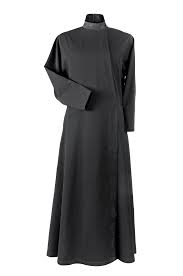
Outer Cassock (Eksorasson, D, P, B)
Like the anderi, the eksorasson, or outer cassock, is a floor-length garment. This one, however, is more loosely fitted and has draped sleeves (see Image 2). This robe is also non-liturgical, so clergy wear it both as ordinary daily clothing and as an undergarment during liturgical services. Wearing the outer cassock is common among bishops, priests, deacons, monks and nuns.
Meaning
Similar to the anderi, the eksorasson also symbolizes death to the world and all worldly things.
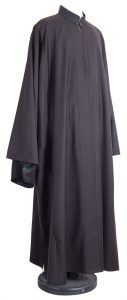
Baptismal Robe (Sticharion: D, P, B)
The first liturgical vestment is called the sticharion, or baptismal robe. It is a long and narrow robe that fastens at the neck, with loose sleeves. Every sacred order of Orthodox clergy wears this vestment, but the design of the vestment differs depending on who wears it.
Priests and bishops wear the sticharion beneath all other vestments. Thus, for priests and bishops the garment is usually a simple white or gold robe (see Image 3). Deacons and subdeacons, on the other hand, wear it as their outermost vestment. So, theirs typically have brighter colors and more intricate embroidery with a cross between the shoulder blades (see Image 4). Additionally, the deacon’s sticharion is open down the sides and held closed by buttons. Some jurisdictions call the deacon’s sticharion a dalmatikon, which was its name in the fourth century, when the vestment was developed.
Meaning
The sticharion symbolizes the “robe of salvation,” the white garment every Christian dons on his day of baptism. Thus, it symbolizes the new humanity of Jesus and life in the Kingdom of God (Rev. 7:9).
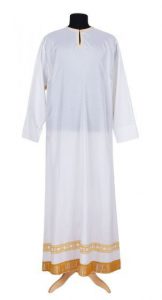
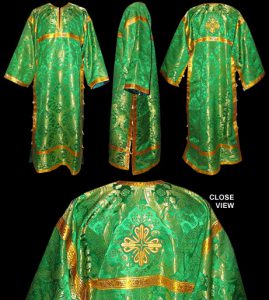
Deacon’s Stole (Orarion: D)
The orarion, or deacon’s stole, is a vestment unique to deacons. Usually 4 inches wide and about 10 feet long, this garment is made of brocade with seven crosses embroidered or appliquéd along its length. The deacon wears it over his left shoulder and drapes the front portion over his left forearm during liturgical services. He often takes this section in his right hand when leading litanies or performing a particular action.
In some traditions, the orarion is longer and is also wrapped once diagonally under the right arm and over the left shoulder. Protodeacons and archdeacons wear this “double orarion,” as do deacons who have served for a certain number of years.
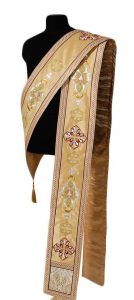
When preparing for Communion, the deacon ties the stole around his waist and brings the ends up over his shoulders. This forms an X-shaped cross on his back. Then he brings the ends down in front and tucks them under the section around his waist.
Cuffs (Epimanikia: D, P, B)
The epimanikia (singular: epimanikion) or fabric cuffs, lace onto the clergyman’s wrists. This vestment contains the sleeves of the baptismal robe, and there is usually a cross in the center (see Image 6). Note: since a deacon wears a more elaborate sticharion, he wears the cuffs underneath the robe and over his cassock sleeves instead.
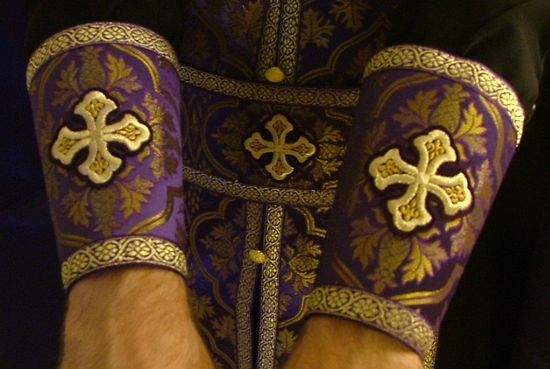
Meaning
The cuffs serve a rather practical purpose: ensuring the sleeves of the sticharion do not get in the priest’s way during worship. However, they still do remind the clergymen that they celebrate and partake of the Mysteries by the power and Grace of God, not on their own merit. The cuffs also serve to remind us of the bonds that tied the Savior’s hands during His Passion.
Pectoral Cross (P, B)
A pectoral cross or pectoral (from the Latin pectoralis, “of the chest”) is a relatively large cross on a chain or cord that hangs from the priest’s or bishop’s neck down to his chest. The pectoral is different from an ordinary cross worn on a necklace by most Christians.
The cross depicts Christ crucified, either in icon form or in relief (no more than 3/4). It also bears the inscription INBI (the title that Pontius Pilate placed above the head of Jesus at the crucifixion) and the letters IC XC NIKA (“Jesus Christ Conquers”) around the arms of the cross. Additionally, they often have an icon of Christ “Made Without Hands” at the top of the cross. In Russian practice, the back of the cross bears St. Paul’s words to Timothy: “Be an example to the believers in speech and conduct, in love, in faith, in purity” (1 Tim. 4:12).
Throughout the Orthodox Church, all bishops wear the pectoral cross. In some jurisdictions (i.e. Slavic, Antiochian), all priests also wear the cross, while in others (i.e. Greek), the pectoral is bestowed as an “award” for faithful service.
Degrees of the Pectoral Cross
Bishops award pectorals to priests in degrees: Silver, Gold, and Jeweled. When a priest is first ordained, he receives the Silver Cross. This cross is plain, and is not decorated or enameled aside from the engraving or relief. This distinguishes them from deacons and monks, who otherwise look exactly the same when not in their vestments.
The Gold Cross is the second degree, which is worn by archpriests, abbots, and abbesses as a mark of their office. Bishops can award these to both married and monastic priests for faithful service in the Church. It is similar to the Silver Cross, in that it is not decorated or enameled.
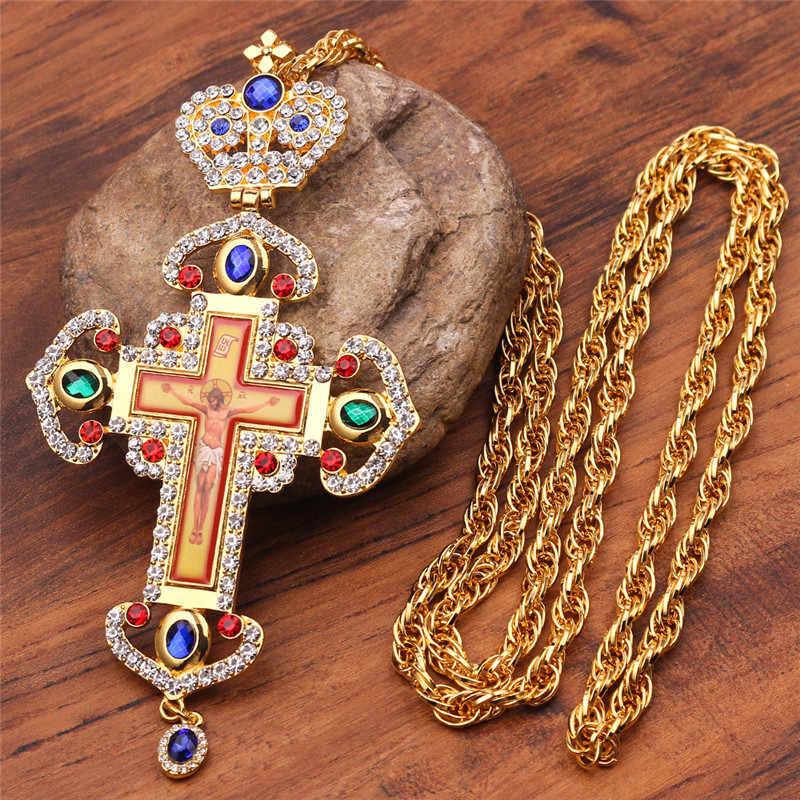
The highest degree is the Jeweled Cross (also With Decorations). As its name implies, this cross usually has jewels on its surface and has an Eastern-style mitre at the top (see Image 7 above). This type of pectoral cross is worn by bishops, archimandrites, and protopriests as a sign of their office. The Jeweled Cross may also be awarded to other priests. All bishops are entitled to wear the pectoral cross with decorations, but most simply choose to wear a Panagia when not vested for services.
Priestly Stole (Epitrachelion: P, B)
The epitrachelion (Greek, “around the neck”) is the stole worn by priests and bishops. This Orthodox liturgical vestment is worn around the neck with the two adjacent sides sewn or buttoned together. The ends extend all the way to the priest’s ankles. Similar to the orarion (deacon’s stole), this vestment has seven embroidered or appliquéd crosses, one at the back of the neck and three down each side.
The priest wears this vestment whenever serving. For some services, like Vespers or Orthros, he wears the stole by itself over the outer cassock. When fully vested for the Divine Liturgy, he wears the stole over the sticharion and under the zone and the phelonion.
If an Orthodox priest simply attends a service, he does not wear liturgical vestments, but will put on the stole (and in many Slavic traditions, his cuffs) before receiving Communion.
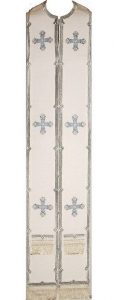
Meaning
This liturgical vestment symbolizes the spiritual yoke of the priesthood. It also symbolizes the double portion of God’s Grace bestowed upon a priest, for the celebration of the Mysteries. It is the one vestment (in the absence of any others) that is absolutely necessary for a priest to conduct any liturgical service. Without it, he cannot serve.
The stole was originally made of wool, which symbolized the sheep, or members of Christ’s flock. Both bishops and priests wear this vestment when exercising their pastoral office, witnessing to the fact that ministers of the Church live and act solely for the members of Christ’s flock.
Belt (Zone)
The zone or belt is the liturgical vestment Orthodox priests and bishops use to fasten the sticharion and epitrachelion to his body. This helps the priest move about during Liturgy without impediment from the other garments.
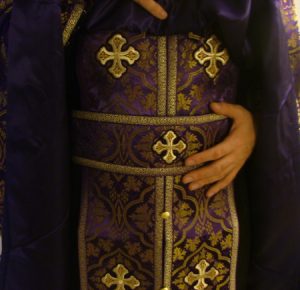
The zone signifies that the priest wears the mortification of the body and chastity, having girded his loins with the power of truth. It also symbolizes the divine power that strengthens the priest during the course of his serving (Psalm 18:32). Further, it reminds us of the towel which the Savior was given for the washing of the disciples’ feet at the Mystical Supper.
Cape (Phelonion: P)
The phelonion (plural, phelonia) is a liturgical vestment worn by Orthodox priests over their other vestments. It is large and sleeveless, like a cape. The front portion of the cape reaches down to the priest’s waist, while the back portion touches down to the ankles. There are two main styles of this vestment. Byzantine or Greek phelonia simply fit over the shoulders, while Russian phelonia have a high, stiffened collar that covers the back of the head (see Images 10 and 11). The use of the phelonion is not limited to the Divine Liturgy, but is specified for any major liturgical function.
A bishop who wishes to serve a Divine Liturgy as a priest (i.e., without the special rites and prayers of the Hierarchical Divine Liturgy) will sometimes vest in a phelonion instead of his sakkos, but with the small omophorion around his neck.
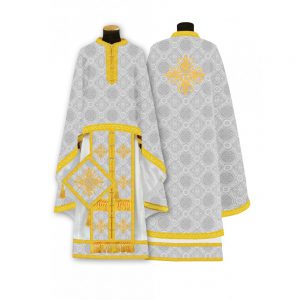
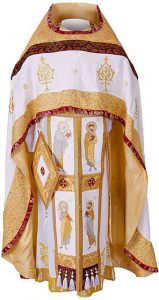
Meaning
The phelonion symbolizes the red tunic with which Pilate dressed our Lord before His Crucifixion. In other words, it reminds us of the torment and suffering a priest endures during his ministry in order to serve God’s faithful. Additionally, the phelonion embodies the garment of righteousness with which priests must be vested as servants of Christ. St. Cosmas the Aetolian adds another layer of meaning to this vestment; because the priest’s hands remain close to his body, they do not receive or attach to worldly things. Thus, the priest can receive the Holy Gifts without anything hindering him.
Epigonation (P, B)
The epigonation (Greek: “over the knee”), or palitza (Russian: “club”), is a diamond-shaped vestment worn over the right knee of priests and bishops. In Byzantine tradition, priests are awarded the epigonation upon elevation to the rank of exomologos, or confessor. In Russian tradition, it is given after many years of service. Though a Russian palitza is identical in shape, and is obviously related to the epigonation, the most literal Slavonic translation for epigonation is actually “Nabedrennik“, which is a different rectangular vestment that no longer exists in non-Slavic usage.
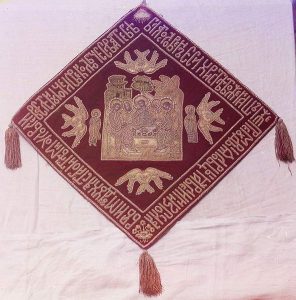
Meaning
The epigonation represents a shield, originating from the thigh shield worn by soldiers during the days of the early church. The epigonation symbolizes two things. First, it denotes the celebrant as a “soldier” of Christ. And second, it symbolizes the “sword of the Spirit, which is the Word of God” (Ephesians 6:17) – the wearer’s defending of the faith by smiting all that is impure and vicious.
Mitre (B)
The mitre/miter, (Greek: “headband”) is a vestment worn on the heads of Orthodox bishops as part of their ceremonial dress. In present times, this vestment is fashioned after the imperial crown of the late Eastern Roman (Byzantine) Empire. It is shaped like a bulbous crown. Mitres are constructed of various materials (i.e. brocade, damask, gold cloth), and in many cases, are decorated with jewels and embroidery. While they come in gold most of the time, mitres do come in other liturgical colors. Additionally, there are four icons attached to the head covering. These are icons of Jesus Christ, the Theotokos, John the Baptist, and the Cross. Atop the crown is a cross, usually upright for a bishop and lying flat for priests.
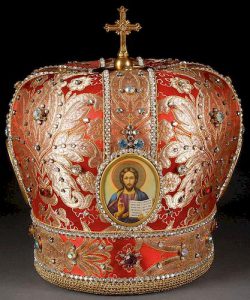
The wearing of the miter is usually exclusive to bishops, but it may also be awarded to archpriests, protopresbyters, and archimandrites.
Panagia (B)
Panagia (Greek: “All-Holy”) is a title given to the Virgin Mary in Orthodox Tradition. This same word also refers to the medallion worn by Orthodox bishops that bears the icon of the All-Holy Theotokos. In some traditions, the medallion is also called an engolpion. The panagia is usually ovular in shape and crowned with a depiction of a mitre (see Image 14).
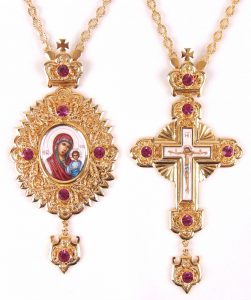
Whenever a bishop vests for the Divine Liturgy or another service, he wears a panagia and a pectoral cross over his other vestments. This is often the detail that helps newcomers and young Orthodox to distinguish a bishop from a priest or a monk. The primate (or Patriarch) of an autocephalous church, when fully vested, wears a panagia, a pectoral cross, and an engolpion of the Christ. Sometimes, bishops may wear a panagia which is either square or shaped like a double-headed eagle. This is especially true of bishops of the Greek tradition.
Sakkos (B)
The sakkos (Greek: “sackcloth”) is a vestment worn by Orthodox bishops in place of the priest’s phelonion. The bishop wears the sakkos whenever celebrating the Divine Liturgy and other services when called out by the rubrics. The sakkos is a tunic with wide sleeves, and a distinctive pattern of trim. It reaches below the knees and fastens up the sides with buttons or ribbons. There is normally a cross centered on the back, which the bishop kisses before it is placed on him. Traditionally, bells are attached to the sakkos, following the biblical directions for the vestments of the Jewish High Priest (Exodus 28:33-34; 39:25-26).
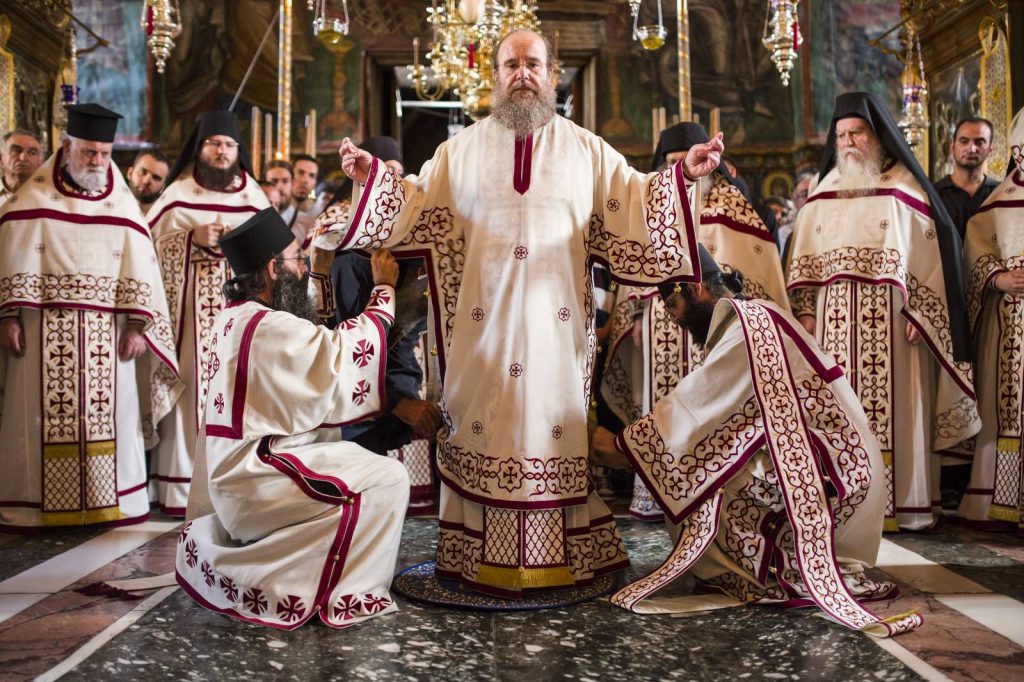
In some traditions, a bishop may choose to celebrate the Liturgy “as a priest”. This means he does not fully vest, nor does he make use of the dikirion and trikirion (liturgical candlesticks). In this case, instead of the sakkos he wears a priestly phelonion, with only the small omophorion (see section below) on his shoulders and the epigonation at his side. Regardless, the bishop will always wear his Panagia engolpion.
Historical developments
Originally, all bishops wore a phelonion similar to the one worn by priests, but woven or embroidered with a multilayered cross pattern called the polystavrion (“many-crosses”). The sakkos was originally worn by the Byzantine Emperor as an imperial vestment, symbolizing the tunic of disgrace worn by Christ during his trial and mockery. Thus, the use of this vestment was a privilege bestowed by the Emperor upon individual patriarchs as a sign of his personal favor. By the thirteenth century all patriarchs, as well as a few high-ranking archbishops, wore it. Other bishops continued to wear the polystavrion. After the fall of Constantinople in 1453, wearing the sakkos came into general use by bishops. In present times, all Orthodox – as well as Byzantine rite Roman Catholic – bishops wear this vestment, regardless of rank.
Omophorion (B)
In the Orthodox liturgical tradition, the omophorion is a vestment for Orthodox bishops, which the bishop wears around his neck and shoulders. Originally of wool, it is a band of brocade decorated with crosses. There are two types of omophorion: great and small. The great omophorion is worn most often. The bishop may wear the small omophorion similarly to the way a priest wears his epitrachelion (see above) out of convenience. In addition, when multiple bishops celebrate liturgy together, it is customary for the chief celebrant to use the great omophorion, while the other bishops wear the small omophorion.
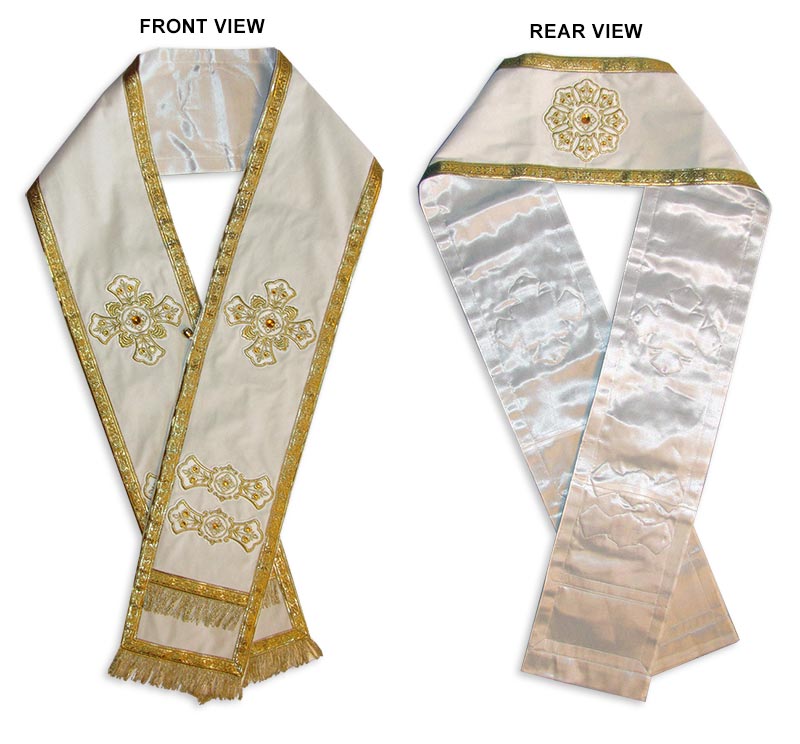
Meaning
The omophorion serves as the symbol of a bishop’s spiritual and ecclesiastical authority. We often say in Orthodoxy that those subject to a bishop’s authority are “under his omophorion”. Further, the omophorion symbolizes the lost sheep that the Good Shepherd (Christ) finds and carries upon His shoulders. In other words, this emphasizes the bishop’s pastoral role as an icon of Christ.
Crozier
The crozier/crosier, (Greek: paterissa; Slavonic: zhezl) is a staff Orthodox bishops and senior monastics (abbots/abbesses) carry as a symbol of authority and jurisdiction. Croziers are usually made of fine metal gilded or silver-plated. Some may also be made of fine wood. These staffs come with one of two tops:
- The Greek letter Tau with the arms curving downward, surmounted by a cross. Tau is the ancient Greek symbol of resurrection and life.
- A pair of serpents or dragons with their heads curled back to face each other, with a small cross between them (see Image 18). This symbolizes the bishop’s diligence in protecting his flock.
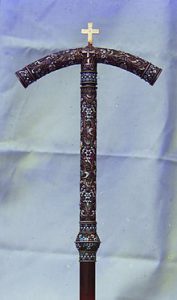
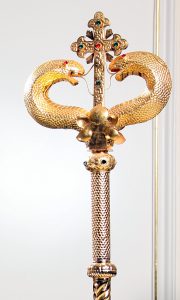
The bishop carries this staff while outside the altar, and does not take it with him into the altar. Before entering the altar, the bishop or monastic will lean the crozier against the iconostasis, next to the icon of Christ to the right of the Royal Doors. Any time a bishop is not serving, he uses a different, smaller staff: a walking stick topped with a silver pommel.
Conclusion
Since the earliest times, vestments have been worn by Orthodox priests, bishops, and deacons. Some remind us of the royal vesture of the kingdoms of history, some derive their shape and function from Scripture. And all of them serve the same primary purpose: the spiritual edification of the Church.
Are there any vestments we missed? Let us know in the comments!
Read More: A Guide To Liturgical Colors In The Orthodox Church

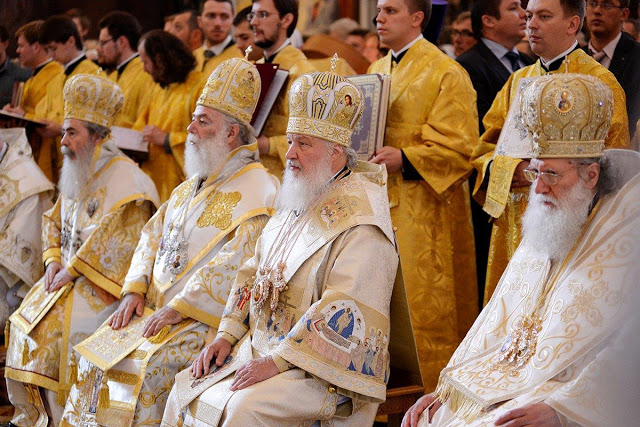
4 Responses
I’m curious about the variety of colours of the vestments throughout the year and services and other priest roles – our priest has another kind of red velvet hat
Gjoa,
Christ is in our midst. This article about liturgical colors may help satisfy your curiosity. Enjoy!
I would like to know what the name/ purpose of the little attachment is that is on the bottom of the pectoral cross and engolpion pictured above. I have looked all over and have yet to see any explanation. Thanks in advance.
Richard,
Christ is in our midst. There is no particular name for the attachment at the bottom, and not all pectoral crosses and engolpions have this attachment. Those that do may simply be decorative, or they may contain additional symbolism. In the image above, for example, the attachment is the double-headed eagle crest, which was the official symbol of the late Byzantine Empire and a well-recognized symbol of Orthodoxy. We hope this is helpful. God bless you!